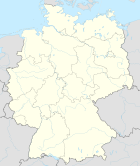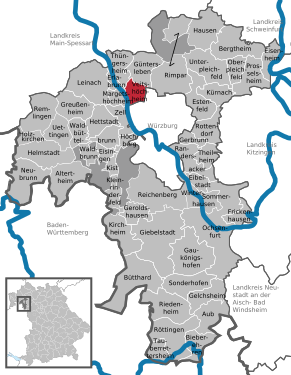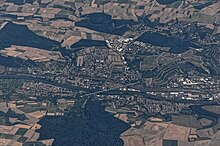Veitshochheim
| coat of arms | Germany map | |
|---|---|---|

|
Coordinates: 49 ° 50 ' N , 9 ° 52' E |
|
| Basic data | ||
| State : | Bavaria | |
| Administrative region : | Lower Franconia | |
| County : | Wurzburg | |
| Height : | 170 m above sea level NHN | |
| Area : | 10.76 km 2 | |
| Residents: | 9525 (Dec. 31, 2019) | |
| Population density : | 885 inhabitants per km 2 | |
| Postal code : | 97209 | |
| Area code : | 0931 | |
| License plate : | WÜ , OCH | |
| Community key : | 09 6 79 202 | |
| LOCODE : | DE VTS | |
| Community structure: | 2 districts | |
| Address of the municipal administration: |
Erwin-Vornberger-Platz 97209 Veitshöchheim |
|
| Website : | ||
| Mayor : | Jürgen Götz ( CSU ) | |
| Location of the municipality of Veitshöchheim in the district of Würzburg | ||
Veitshöchheim is a municipality in the Lower Franconian district of Würzburg and is located on the Main .
geography
Community structure
Veitshöchheim is divided into two districts (the type of settlement in brackets):
- Veitshoechheim ( parish village )
- Gadheim ( Kirchdorf )
Neighboring communities
In the north are the communities Erlabrunn , Thüngersheim and Güntersleben ; the eastern neighboring communities are Rimpar and Estenfeld . In the south, Veitshöchheim borders directly on Würzburg , and Zell am Main is also in the south . To the west on the opposite side of the Main is the municipality of Margetshöchheim .
Surname
etymology
The original name Hochheim consists of the Old High German adjective hôch and the Old High German word heim . Later the name of the church patron St. Vitus / St. Veit added to the name to distinguish the place from Margetshöchheim on the opposite side of the Main.
Earlier spellings
| year | Notation |
|---|---|
| 1097 | Hocheim |
| 1250 | Hochheim |
| 1301 | Ho e cheim ad sanctum Vitum |
| 1350 | Sant Vitus Hocheim |
| 1362 | Sant Veytz Ho e cheim |
| 1376 | Vitsho e cheym |
| 1554 | Veitshocheim |
| 1575 | Veitshöcheim |
| 1579 | Veitshochheim |
history
Until the 19th century
Veitshöchheim was first mentioned in 779. In the year 1246 the election of the German king took place in the place, Heinrich Raspe emerged as the winner. A separate coat of arms for Veitshöchheim was granted by Prince-Bishop Friedrich von Wirsberg at the request of the community leaders in 1563 .
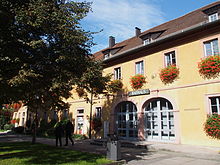

The Veitshöchheim castle was in the years 1680 to 1682 under the Prince Bishop Peter Philipp von Dernbach built and 1749-1753 by Balthasar Neumann extended. The construction of the court garden, which belongs to the castle, began in 1702. The parish church of St. Vitus , which is still preserved today , was consecrated in 1691, and the Veitshöchheim synagogue was built between 1727 and 1730.
In 1814, the place finally fell to the State of Bavaria , after having come to the Grand Duchy of Würzburg only nine years earlier . The municipality was formed in its current form in the course of the Bavarian administrative reforms in 1818 . The Veitshöchheim train station with the royal pavilion was built in 1853 and 1854 under Maximilian II of Bavaria.
Incorporations
On July 1, 1976, the previously independent municipality of Oberdürrbach was dissolved. Its main part was reclassified to the city of Würzburg. The church village of Gadheim came to Veitshöchheim.
Population development

politics
Municipal council
The Veitshöchheim municipal council has had 20 members again since May 1, 2020, as the population is now below 10,000 (until April 2020: 24 municipal councilors). The election on March 15, 2020 had the following result:
| Seats | Share of votes | |
|---|---|---|
| CSU / Veitshöchheimer center | 9 | 43.48% |
| Alliance 90 / The Greens | 5 | 22.22% |
| SPD | 3 | 16.36% |
| Independent voter community - Free Voters Veitshöchheim | 3 | 15.54% |
| FDP | 0 | 2.41% |
| total | 20th | 100.00% |
The turnout was 59.35%.
Compared to the 2014 to 2020 term of office, the municipal council has been reduced by four seats. While Bündnis 90 / Die Grünen gained two seats, the SPD lost four seats. The CSU / Veitshöchheimer Mitte and the Independent Voting Association / Free Voters Veitshöchheim each had to give up one seat.
mayor
Jürgen Götz (SU / Veitshöchheimer Mitte) has been mayor since May 1, 2014. He was elected for a further six years on March 15, 2020 with no opposing candidate with a turnout of 59.3% with 92.12% of the votes. His predecessor was Rainer Kinzkofer (SPD), who had headed the community since September 10, 1986 and did not run for re-election in 2014.
coat of arms

The description reads: “In red, an unclothed, golden nimbed man protruding from a three-legged, two-handled golden cauldron in natural colors with hands folded in front of his chest, accompanied by a six-pointed golden star on the top right and left. The black number "15" is affixed to the left and the black number "63" to the right in the recesses (spear rests) of the tartsch shield. "
Declaration of coat of arms: The coat of arms shows the martyrdom of Saint Vitus (St. Vitus) in the cauldron, the patron saint of Veitshöchheim. The numbers in the spear rests of the double archery shield form the year "1563", which refers to the year the coat of arms was granted to the community on July 26, 1563 by Prince-Bishop Friedrich von Wirsberg .
Town twinning
-
 Geithain (Saxony) since 1990
Geithain (Saxony) since 1990
-
 Greve Chianti (Italy) since 1994
Greve Chianti (Italy) since 1994
-
 Pont-l'Évêque (France) since 1995
Pont-l'Évêque (France) since 1995
-
 Rotava (Czech Republic) since 2006
Rotava (Czech Republic) since 2006
Culture and sights
Museums
Buildings
- The courtyard garden of Veitshöchheim Palace is one of the most beautiful Rococo gardens in Europe . The garden figures come from Ferdinand Tietz
- Veitshöchheim Castle , built 1680–1682 by Prince-Bishop von Dernbach; Expanded from1749–1753 by Balthasar Neumann
- Jewish Culture Museum Veitshöchheim
- Parish Church of St. Vitus
- Erwin-Vornberger-Platz
- Railway station (built around 1850)
- Trinity shrine
- Catholic rectory
- Prince-Bishop's winery, the old vaulted cellar is worth seeing
- Martinsbrunnen (Märzebrünnle), the oldest fountain in the municipality
- Martinskapelle, one of the oldest churches in the Würzburg district
- Hermit mill
- Markuskapelle (district of Gadheim)
- Show garden of the Bavarian State Institute for Viticulture and Horticulture (An der Steige)
- Kuratiekirche for the Holy Trinity (garden settlement)
- Mainfrankensäle
Regular events
- The Altortfest was an annual summer festival with culinary specialties, but is no longer held.
- Carnival in Franconia , the ceremonial meeting of the FVF , which is broadcast annually by Bavarian television , makes the place known nationwide.
- Open day of the Bavarian State Institute for Viticulture and Horticulture, every two years on the first Sunday in July, alternating annually with the location in Bamberg.
- Last load, a wine festival
Special
- The view from the Main promenade to the “garden village” Margetshöchheim opposite.
- The Veitshöchheim main valley bridge on the Hanover – Würzburg high-speed line was mentioned in the Guinness Book of Records in 1986 as the longest bridge ever built using the unilateral incremental launching method.
Economy and Infrastructure
Jobs
In 2017 there were 3882 jobs subject to social security contributions in the municipality. Of the resident population, 3552 people were in an employment relationship subject to compulsory insurance. This meant that the number of inbound commuters was 330 more than that of outbound commuters. 144 inhabitants were unemployed.
traffic
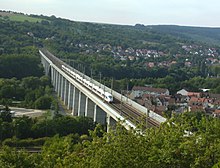
The Altort is a restricted traffic area. The entire place is located in such a way that only residents and tourists go to the old town. The busiest road in Veitshöchheim is the district road WÜ 3, which leads from the B 27 through the local area via Güntersleben to Rimpar .
Street
Veitshöchheim is located directly on the B 27 from Würzburg to Fulda . The distance to Würzburg is about 6 km. The A 3 and A 7 motorways are nearby .
bus and train
Veitshöchheim is connected to the local public transport network by buses and trains. Two bus routes lead from Würzburg to Veitshöchheim (route 11 and 19). The place also has a train station on the Main-Spessart-Bahn , which is served every hour by the regional train. The Veitshöchheim main valley bridge on the Hanover – Würzburg high-speed line passes the Hofgarten in the immediate vicinity.
Passenger shipping
Between April and October, passenger ships run to Würzburg several times a day . The journey time to the landing stage at the Alter Kranen in Würzburg is around 45 minutes.
car sharing
Since November 2016 there has been a car sharing car in the old town in the parking lot north of the train station and the library . On February 15, 2019, the offer was discontinued without replacement due to insufficient response.
Charging stations
There are three charging stations for electric vehicles in Altort and one in Gadheim.
Viticulture
With the Veitshöchheimer Sonnenschein one has a " VDP Erste Lage". The only local winery is the Hessler winery in Wolfstalstrasse.
Public facilities
Educational institutions
- Veitshöchheim elementary school with the Vitus school as a branch in the old town.
- Veitshöchheim Middle School
- Veitshöchheim High School
- Bavarian State Institute for Viticulture and Horticulture
- Rupert Egenberger School for individual learning support
- Berufsförderungswerk Würzburg (vocational training facility for the blind and visually impaired)
- Caritas vocational training center Don Bosco for gardeners and hotel specialists, St. Markushof branch
- Singing and music school
- Library in the train station
Leisure and sports facilities
- Geisbergbad (outdoor pool)
- Outdoor sports facility with triple gymnasium, teaching pool and beach volleyball facility
- Tennis courts
- Skater place
- Mini golf course
- four soccer fields
Authorities - Bundeswehr
The headquarters of the 10th Panzer Division (10th PzDiv), one of the largest divisions in the Army , including the headquarters and communications company of the 10th Panzer Division and the Veitshöchheim Army Music Corps are stationed in the Balthasar Neumann barracks in Veitshöchheim . In addition, the 5th / 3rd Field Jäger Regiment is based in the barracks.
The barracks used to be the location of the 12th Panzer Division , the 12th Telecommunications Battalion, the 12th Medical Battalion, the headquarters company of the 12th Logistics Battalion and the Veitshöchheim driver training center. After the 12th Panzer Division was dissolved, the 36th Panzer Brigade was stationed in Veitshochheim. After its dissolution, the Airmobile Operations Division was set up in the barracks. After its dissolution, it was followed by the 10th Panzer Division, which was previously stationed in Sigmaringen. In addition, the Bundeswehr Service Center Veitshöchheim can be found as the local authority of the territorial defense administration .
At the Bundeswehr Fachschule Würzburg, which is also part of the territorial military administration , retiring soldiers can acquire higher-quality school qualifications (intermediate school leaving certificate and technical college qualification) in the last years of their active service.
gastronomy
Today there are more than 25 restaurants, beer gardens and cafés in the village, including the Ratskeller , which was renovated in 2011, and the hotel and wine restaurant Spundloch .
Personalities
Sons and daughters of the church
- Saint Bilhildis von Altmünster (around 655/660 – around 750), founder and first abbess of the Benedictine monastery Altmünster in Mainz , according to legend, born in Veitshöchheim
- Johann Michael Fischer (1717–1801), sculptor and student of Johann Wolfgang von der Auwera
- Simon Höchheimer (1744–1828), physician and religious educator for the equality of Jews
- Will Klinger-Franken (1909–1986), painter
- Brigitte Wolf (* 1947), German Wine Queen from 1968 to 1969
Personalities who have worked in the place
- Siegfried III. von Eppstein (around 1194–1249), Archbishop of Mainz and thus ex officio Arch Chancellor of the Holy Roman Empire , had Heinrich Raspe IV elected king in 1246 by a minority of the German princes in Veitshöchheim
- Heinrich Raspe IV (1204–1247), Landgrave of Thuringia and anti-king to Emperor Friedrich II and his son Conrad IV , was elected king in 1246 by a minority of German princes in Veitshöchheim
- Adolf I (Waldeck and Schwalenberg) († 1270), Count, was present at the election of Heinrich Raspe IV in Veitshöchheim in 1264, where he attested to a document issued by Raspe in favor of Corvey Abbey
- Johann Gottfried von Guttenberg (1645–1698), Prince-Bishop of Würzburg, donated an altar to the Church of St. Vitus in Veitshöchheim in 1691
- Balthasar Neumann (1687–1753), Baroque and Rococo builder, built Veitshöchheim Castle in 1753
- August von Limburg-Stirum (1721–1797), Prince-Bishop of Speyer from 1770 to 1797 , stopped in Veitshöchheim in 1792 while fleeing from the French Revolutionary Army
- Constantin Maria von Droste zu Hülshoff (1841–1901), German Franciscan in the diocese of La Crosse (Wisconsin), grew up in Veitshöchheim
- Therese Dahn (1845–1929), German writer and honorary senator of the University of Breslau , grew up in Veitshöchheim
- Joseph Oppenheimer (1876–1966), landscape and portrait painter, made Veitshöchheim Castle the subject of his paintings
- Gustav Kafka (1883–1953), psychologist, died in Veitshöchheim
- Fried Heuler (1889–1959), sculptor and graphic artist, lived in Veitshöchheim until his death
- Hubert Groß (1896–1992), architect and town planning officer, owned a property built in 1938 in Veitshöchheim
- Diether Hummel (1908–1989), sparkling wine producer, received his training at the Bavarian State Institute for Viticulture and Horticulture in Veitshöchheim
- Hans Breiter (1908–2000), oenologist, was the managing director of the Bavarian State Institute for Viticulture and Horticulture in Veitshöchheim from 1959 to 1973
- Gerd Schmückle (1917–2013), General, served from 1968 to 1979 as deputy commander of the 12th Panzer Division of the German Armed Forces in Veitshöchheim
- Gert Bastian (1923–1992), major general and politician, led the 12th Panzer Division of the Bundeswehr in Veitshöchheim from 1976 to 1980
- Hermann Schweppenhäuser (1928–2015), philosopher and publicist, lived in a nursing home in Veitshöchheim from 2013 until his death
- Helge Hansen (* 1936), retired general D., was a staff officer ( G1 ) of the 12th Panzer Division from 1967 to 1971
- Klaus Werner Eichhorn (1938–1994), agricultural scientist, attended the viticulture school in Veitshöchheim
- Hartmut Bagger (* 1938), General a. D., headed the 12th Panzer Division of the Bundeswehr in Veitshöchheim from 1990 to 1992
- Klaus von Klitzing (* 1943), winner of the 1985 Nobel Prize in Physics, lived in Veitshöchheim during his time as a doctoral and post-doctoral candidate at the Physics Institute of the University of Würzburg .
- Norbert van Heyse (* 1944), Lieutenant General ret. D., commanded telecommunications battalion 12 in Veitshöchheim from 1982 to 1984
- Klaus Olshausen (* 1945), Lieutenant General ret. D., served from 1978 to 1980 as intelligence officer ( G2 ) of the 12th Panzer Division in Veitshöchheim
- Fredi Albrecht (* 1947), wrestler and referee, has lived in Veitshöchheim since 1990
- Carl-Hubertus von Butler (* 1950), former lieutenant general D., commanded the airmobile operations division of the Bundeswehr in Veitshöchheim from 2005 to 2009
- Ernst-Otto Berk (* 1952), retired Brigadier General D., was in command of the Telecommunications Battalion 12 in Veitshöchheim from 1991 to 1993
- Paul Beinhofer (* 1953), former district president D., lives in Veitshöchheim
- Bernhard Winkler (* 1966), former soccer player and coach, started playing soccer at SV Veitshöchheim
- Martin Rassau (* 1967) and Volker Heissmann (* 1969), actors and comedians, have been an integral part of the program Fastnacht in Franken in Veitshöchheim since 1997 as Waltraud and Mariechen
- Maximilian Kleber (* 1992), basketball player, grew up in Veitshöchheim
literature
- Thomas Struchholz: Veitshöchheim. A chronicle from Franconia. Struchholz Kunst GbR, Veitshöchheim 2012, ISBN 978-3-9812318-4-7 .
Web links
- Official website of the Veitshöchheim community
- Virtual tour through the community of Veitshöchheim
- Entry on the coat of arms of Veitshöchheim in the database of the House of Bavarian History
- Veitshöchheim: Official statistics of the LfStat (PDF; 1.1 MB)
Individual evidence
- ↑ "Data 2" sheet, Statistical Report A1200C 202041 Population of the municipalities, districts and administrative districts 1st quarter 2020 (population based on the 2011 census) ( help ).
- ^ Veitshoechheim. on the website Bayerische Landesbibliothek Online
- ↑ a b Wolf-Armin von Reitzenstein : Lexicon of Franconian place names. Origin and meaning . Upper Franconia, Middle Franconia, Lower Franconia. CH Beck, Munich 2009, ISBN 978-3-406-59131-0 , p. 229 ( limited preview in Google Book search).
- ^ Federal Statistical Office (ed.): Historical municipality directory for the Federal Republic of Germany. Name, border and key number changes in municipalities, counties and administrative districts from May 27, 1970 to December 31, 1982 . W. Kohlhammer, Stuttgart / Mainz 1983, ISBN 3-17-003263-1 , p. 755 .
- ↑ 2020 municipal council election , accessed on July 13, 2020
- ↑ Mayoral election 2020
- ↑ 21 years of Mayor Rainer Kinzkofer. (PDF; 18.5 MB)
- ↑ Veitshöchheim: Altortfest canceled. In: Mainpost. June 12, 2009.
- ^ Open day of the LWG on July 3rd in Bamberg. Bavarian State Institute for Viticulture and Horticulture, accessed on February 27, 2017 .
- ↑ Guinness Book of Records. Ullstein-Verlag, 1990, p. 189.
- ↑ K. Flügel: The construction of the Main Valley Bridge Veitshöchheim - a new world record in incremental pushing.
- ^ Website of Veitshöchheimer Personenschifffahrt GmbH. Retrieved May 5, 2017 .
- ^ Website of the ship tourism Würzburg. Retrieved May 5, 2017 .
- ↑ Website of the climate protection management. Retrieved October 20, 2017 .
- ↑ Welcome. Retrieved May 30, 2019 (German).
- ↑ Home - Veitshöchheim Middle School. Retrieved May 30, 2019 .
- ↑ Veitshöchheim protects the climate: Ratskeller .
- ^ Bunghole: website .
- ^ Nobel laureate in Würzburg. (PDF; 253 kB) Sparkassen Foundation Würzburg.
